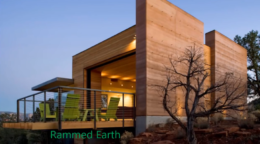
Table of Contents
Building an off-grid house with passive solar space heating requires careful selection of materials that can maximize energy efficiency and thermal comfort. The best materials for such a house are those that provide excellent insulation, thermal mass, and solar gain while being sustainable and durable. Here are some materials commonly used in passive homes and why they are considered better than other options:
- Insulated Concrete Forms (ICFs): ICFs are excellent for both insulation and thermal mass. They consist of insulating foam blocks filled with concrete. They provide exceptional insulation, reducing the need for additional heating or cooling. ICFs also have a high thermal mass, which helps stabilize indoor temperatures.
- Straw Bale Construction: Straw bales are an eco-friendly choice with superb insulation properties. They offer high thermal resistance and can be used as the primary wall material, providing a comfortable and energy-efficient living environment.
- Rammed Earth: Rammed earth construction involves compacting layers of earth and small stones to create solid, thick walls. Rammed earth structures have excellent thermal mass properties, absorbing heat during the day and releasing it slowly at night. They provide natural insulation and are particularly well-suited for passive solar designs.
- Thermal Mass Materials: Materials like concrete, stone, or adobe are ideal for thermal mass. They absorb heat during the day and release it slowly at night, helping to regulate indoor temperatures. These materials can be incorporated into the design as floors, walls, or interior partitions.
- Low-E Coated Windows: High-quality, low-emissivity (Low-E) coated windows allow sunlight to enter while minimizing heat loss. They prevent heat from escaping in cold weather and keep excessive heat out in the summer, making them crucial for passive solar design.
- Solar Collectors: Passive solar homes often include south-facing windows with overhangs to maximize solar gain during the winter months while shading the interior during the summer. This design feature helps control the amount of heat entering the house.
- Natural Insulation: Materials like sheep’s wool, recycled denim, or cellulose insulation are sustainable and effective at insulating walls and roofs. They are environmentally friendly alternatives to conventional fiberglass insulation.
- SIPs (Structural Insulated Panels): SIPs consist of an insulating foam core sandwiched between two structural panels. They offer excellent insulation and air tightness, making them energy-efficient and quick to install.
- Roofing Materials: Metal roofing can reflect sunlight and minimize heat gain, while cool roofing materials like white or reflective coatings help maintain cooler indoor temperatures.
- Earth-Sheltered Homes: For maximum insulation and thermal mass, some off-grid homes are partially or fully earth-sheltered. This design takes advantage of the earth’s natural insulation properties.
- Passive Solar Design Software: While not a material, using passive solar design software can help optimize the placement and size of windows and thermal mass elements for your specific location and climate, ensuring the best use of available sunlight.
These materials and design strategies, including rammed earth, are considered better for off-grid passive solar homes because they enhance energy efficiency, reduce heating and cooling costs, and promote sustainability. They enable homeowners to harness the power of natural sunlight and thermal mass to create a comfortable living space while minimizing reliance on external energy sources. Additionally, many of these materials have a lower environmental impaTo improve the article “Best Materials for Off-Grid Passive Homes,” I will make sure it follows best SEO practices, expand it if necessary, and focus on the keyword usage. The focus keyword will be “Best Materials for Off-Grid Passive Homes.”
Let me rewrite the article based on the criteria provided:
Best Materials for Off-Grid Passive Homes
Building an off-grid house with passive solar space heating requires careful material selection to maximize energy efficiency, thermal comfort, and sustainability. Choosing the right materials for an off-grid home is essential for reducing heating and cooling costs while maintaining durability and environmental responsibility. Below, we explore the best materials for off-grid passive homes, highlighting why they excel in thermal performance and energy efficiency.
1. Insulated Concrete Forms (ICFs)
ICFs are among the best materials for off-grid passive homes due to their combined insulation and thermal mass properties. Made from insulating foam blocks filled with concrete, ICFs offer exceptional insulation, significantly reducing the need for additional heating or cooling. Their thermal mass stabilizes indoor temperatures by storing heat during the day and releasing it at night. Additionally, ICFs are durable and fire-resistant, making them ideal for a sustainable, off-grid passive home.
2. Straw Bale Construction
For those looking to build eco-friendly homes, straw bale construction is an excellent choice. Straw bales provide impressive thermal resistance, making them perfect for walls and insulation. Straw bales not only create an energy-efficient living environment but also help reduce the environmental impact by utilizing natural, renewable materials. Their insulation properties can keep indoor spaces warm in winter and cool in summer, making them one of the best materials for off-grid passive homes.
3. Rammed Earth
Rammed earth construction involves compacting layers of natural earth to create thick, solid walls. The high thermal mass of rammed earth makes it ideal for passive solar designs. It absorbs heat during the day and releases it slowly during the night, helping regulate indoor temperatures. Rammed earth is a sustainable, durable material that has been used for centuries in various climates, making it a prime candidate for off-grid passive homes.
4. Thermal Mass Materials
When designing a passive solar home, incorporating thermal mass materials like concrete, stone, or adobe into floors, walls, or partitions is crucial. These materials store heat energy during the day and release it during cooler periods, naturally maintaining comfortable indoor temperatures. Their ability to regulate heat flow makes them some of the best materials for off-grid passive homes, as they reduce reliance on artificial heating or cooling systems.
5. Low-E Coated Windows
Windows play a significant role in passive solar home designs. Low-E (low-emissivity) coated windows allow sunlight to enter while minimizing heat loss. In winter, these windows prevent heat from escaping, and in summer, they keep excessive heat out, maintaining a comfortable indoor environment. For anyone building an off-grid home, Low-E windows are an essential investment in energy efficiency and are considered some of the best materials for off-grid passive homes.
6. Solar Collectors and South-Facing Windows
While not a “material” in the traditional sense, solar collectors and south-facing windows are crucial elements in passive solar designs. These windows allow maximum solar gain during the winter while being shielded from direct sunlight during the summer. By strategically placing windows and using overhangs or shades, you can harness the sun’s energy to heat your home naturally. Solar gain is vital for maintaining energy efficiency, making it a key consideration in off-grid passive homes.
7. Natural Insulation Materials
Sustainable insulation materials such as sheep’s wool, recycled denim, or cellulose are highly effective in off-grid homes. These materials are eco-friendly and provide excellent insulation, helping reduce energy costs. Sheep’s wool insulation is biodegradable and offers high moisture resistance, while recycled denim and cellulose are made from recycled materials, making them great choices for sustainable living.
8. SIPs (Structural Insulated Panels)
SIPs (Structural Insulated Panels) are pre-fabricated panels that consist of insulating foam cores sandwiched between two structural panels. They offer outstanding insulation, air-tightness, and ease of installation, reducing labor costs and increasing energy efficiency. SIPs are among the best materials for off-grid passive homes because they contribute to a more energy-efficient structure.
9. Reflective and Cool Roofing Materials
When choosing roofing for an off-grid home, metal roofing is a popular choice due to its ability to reflect sunlight and minimize heat gain. Additionally, using cool roofing materials such as reflective coatings can help maintain cooler indoor temperatures, reducing the need for air conditioning. Roofs play a key role in regulating heat, making reflective roofing materials essential in off-grid passive homes.
10. Earth-Sheltered Homes
Earth-sheltered homes take advantage of the earth’s natural insulation properties by partially or fully embedding the structure into the ground. This design technique offers maximum insulation, reducing energy costs and creating a more temperature-stable living environment. Earth-sheltered designs, combined with other sustainable materials, make for highly energy-efficient and environmentally friendly homes.
Conclusion
The best materials for off-grid passive homes are those that enhance energy efficiency, maintain indoor comfort, and minimize environmental impact. By using materials such as ICFs, rammed earth, straw bales, and Low-E windows, homeowners can create structures that maximize thermal performance while reducing their reliance on external energy sources. Whether you are building from scratch or retrofitting an existing home, selecting the right materials will significantly improve your home’s sustainability and energy efficiency.
